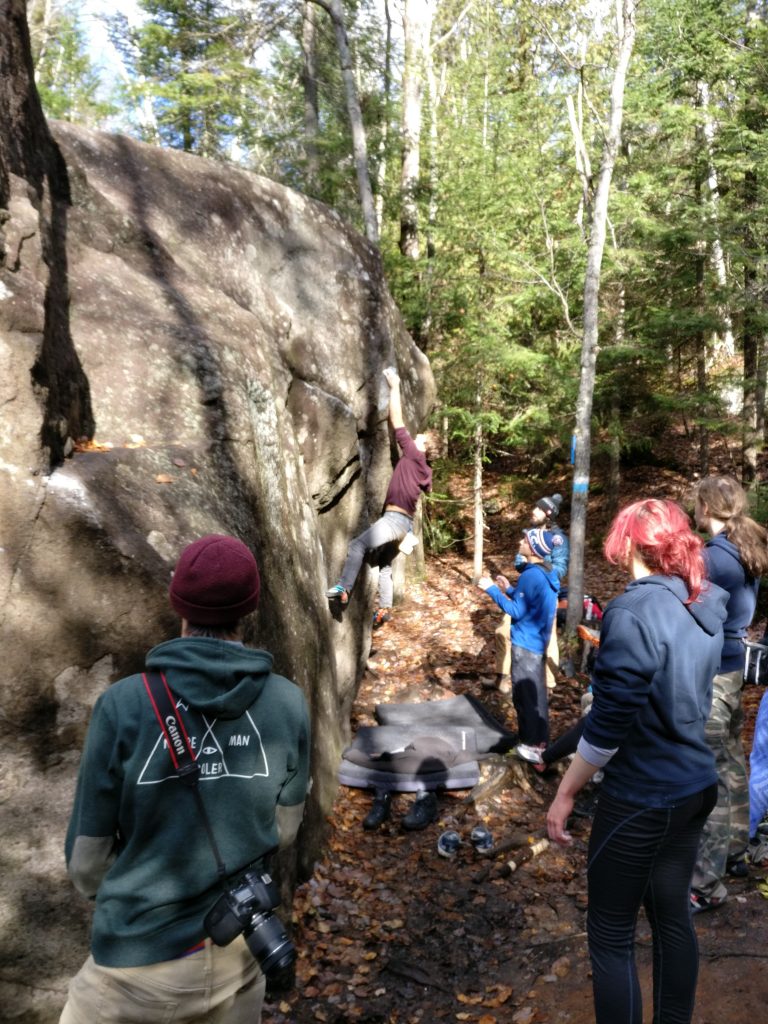Going on an adventure to Val-David with some brave students
On a cool November morning, 15 Concordia students met at the McDonald’s next to Côte-Vertu metro. It’s a good place to meet, eat a heavy breakfast and drink plenty of coffee before heading out for a day of bouldering.
What is bouldering?
It may sound silly, but bouldering is the sport of climbing boulders. Unlike rock or mountain climbing, the goal is not just to get to the top, but to get there by solving a “problem,” by working through a series of moves on small, often overhanging holds. In this sport, the emphasis is on difficulty. Boulderers fall often and when they do, they fall on to crash pads—small mattress-type cushions that soften the impact.
For these Concordia students, bouldering is a fun way to spend a day in the woods with your friends, working on “problems.”
Five cars left the metro station and headed north that morning towards Val-David, Que., a picturesque, alpine-style village in the Laurentians.
Best known as a pit stop along the Petit-Train-du-Nord bike path, Val-David is a quaint tourist spot. The town is divided by two rivers. It has a church, dozens of small restaurants, cafés and bakeries, and is situated in a valley, surrounded by rolling hills that turn bright orange and red this time of year.
What many people do not know about Val-David is that it is the heartland of climbing in Quebec. According to the Val-David guidebook, climbing legends like Paul Laperriere and Bernard Poisson cut their teeth on the cliffs near the town in the 50s and 60s. Before long, those pioneers had revolutionized the sport in Quebec, pushing physical limits while exploring what seemed like a never-ending collection of walls, caverns and pinnacles.
The Val-David regional park has more than 500 climbing routes.

By the late 70s, it is fair to say that Val-David climbing was well-established and well-known, at least within the Quebec climbing community, according to the Val-David climbing guidebook. What was only beginning to become known was a new sport: bouldering.
Today, bouldering is taking the world by storm. According to the International Federation of Sport Climbing, seven thousand people attended the Bouldering World Cup finals in Paris, France earlier this year. Thousands more watched the event online.
Why is it becoming so popular? The simplicity of the sport is to blame, according to Nick McCullagh, one of the executives of the Concordia Rock Climbing Association.
“It’s so simple and aesthetic: whether you succeed or not depends on if you can do the moves to get to the top. There’s no complicated rules,” he said.
Of course, it’s much more complex than that, as the students who went to Val-David discovered. The problems on the Val-David boulders are hard and physical, requiring impressive finger strength. Some students rose to the occasion, attempting difficult problems and sometimes “topping out”—finishing the problem by getting to the top of the boulder. Others stayed on the easier rocks and were introduced to the sport, learning the definitions of discipline-specific jargon like “gaston” and “figure-four,” both of which are just fancy names for moves that boulderers use to get up the walls.
The students also learned the definition of “sending-season.” It’s that time of year when it is so cold outside that skin-on-rock friction is improved. It happens when temperatures drop to around 0 C and it’s when most professional boulderers finally “send their projects,” meaning they get to the top of boulders they’ve been trying to climb for a long time.
It was so cold on that November day that it snowed, but according to some, there’s nothing better than bouldering in the snow. “If you fall and your friends don’t catch you on the crash pad, then you’ll land in the snow and that’s just as good,” said Matthew Packer, an experienced boulderer who was with Concordia at Val-David that day.
How do you finish off a day of wrestling with boulders, a day of defying gravity? The Concordia climbers ended up at Le Mouton Noir, one of Val-David’s popular local restaurants, sharing stories, laughing, drinking and nursing injured fingers. Time well spent in good company, each and every one of them ready to do it again.




